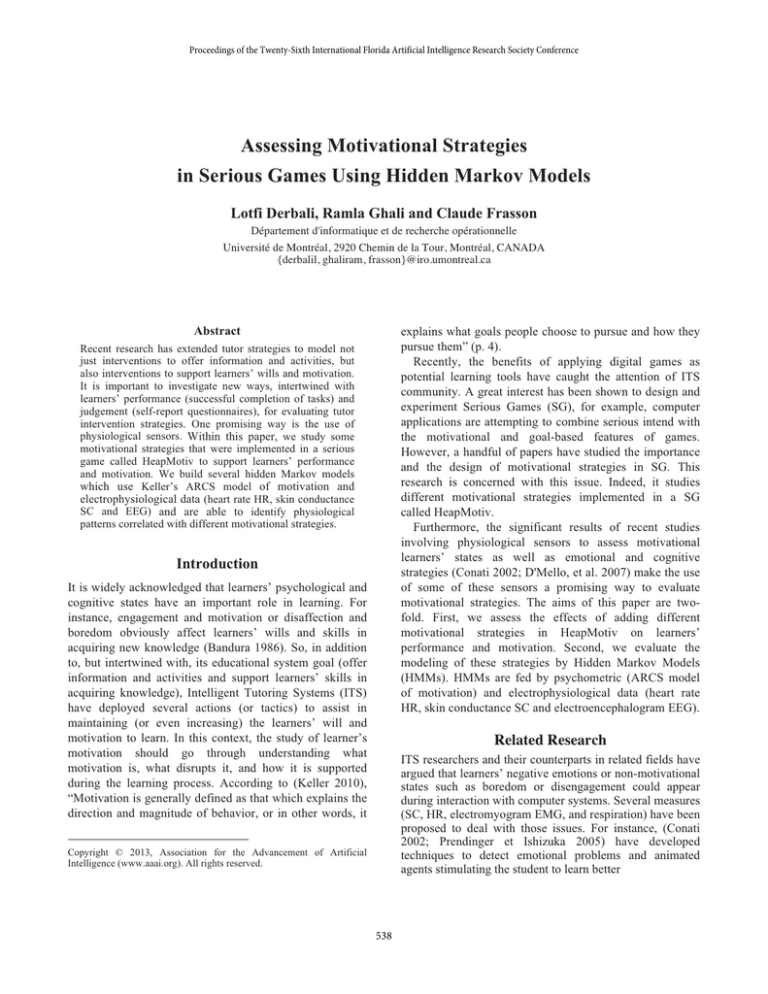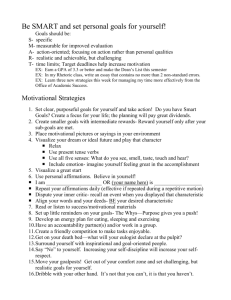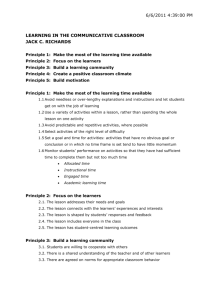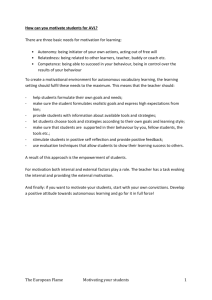
Proceedings of the Twenty-Sixth International Florida Artificial Intelligence Research Society Conference
Assessing Motivational Strategies
in Serious Games Using Hidden Markov Models
Lotfi Derbali, Ramla Ghali and Claude Frasson
Département d'informatique et de recherche opérationnelle
Université de Montréal, 2920 Chemin de la Tour, Montréal, CANADA
{derbalil, ghaliram, frasson}@iro.umontreal.ca
explains what goals people choose to pursue and how they
pursue them” (p. 4).
Recently, the benefits of applying digital games as
potential learning tools have caught the attention of ITS
community. A great interest has been shown to design and
experiment Serious Games (SG), for example, computer
applications are attempting to combine serious intend with
the motivational and goal-based features of games.
However, a handful of papers have studied the importance
and the design of motivational strategies in SG. This
research is concerned with this issue. Indeed, it studies
different motivational strategies implemented in a SG
called HeapMotiv.
Furthermore, the significant results of recent studies
involving physiological sensors to assess motivational
learners’ states as well as emotional and cognitive
strategies (Conati 2002; D'Mello, et al. 2007) make the use
of some of these sensors a promising way to evaluate
motivational strategies. The aims of this paper are twofold. First, we assess the effects of adding different
motivational strategies in HeapMotiv on learners’
performance and motivation. Second, we evaluate the
modeling of these strategies by Hidden Markov Models
(HMMs). HMMs are fed by psychometric (ARCS model
of motivation) and electrophysiological data (heart rate
HR, skin conductance SC and electroencephalogram EEG).
Abstract
Recent research has extended tutor strategies to model not
just interventions to offer information and activities, but
also interventions to support learners’ wills and motivation.
It is important to investigate new ways, intertwined with
learners’ performance (successful completion of tasks) and
judgement (self-report questionnaires), for evaluating tutor
intervention strategies. One promising way is the use of
physiological sensors. Within this paper, we study some
motivational strategies that were implemented in a serious
game called HeapMotiv to support learners’ performance
and motivation. We build several hidden Markov models
which use Keller’s ARCS model of motivation and
electrophysiological data (heart rate HR, skin conductance
SC and EEG) and are able to identify physiological
patterns correlated with different motivational strategies.
Introduction
It is widely acknowledged that learners’ psychological and
cognitive states have an important role in learning. For
instance, engagement and motivation or disaffection and
boredom obviously affect learners’ wills and skills in
acquiring new knowledge (Bandura 1986). So, in addition
to, but intertwined with, its educational system goal (offer
information and activities and support learners’ skills in
acquiring knowledge), Intelligent Tutoring Systems (ITS)
have deployed several actions (or tactics) to assist in
maintaining (or even increasing) the learners’ will and
motivation to learn. In this context, the study of learner’s
motivation should go through understanding what
motivation is, what disrupts it, and how it is supported
during the learning process. According to (Keller 2010),
“Motivation is generally defined as that which explains the
direction and magnitude of behavior, or in other words, it
Related Research
ITS researchers and their counterparts in related fields have
argued that learners’ negative emotions or non-motivational
states such as boredom or disengagement could appear
during interaction with computer systems. Several measures
(SC, HR, electromyogram EMG, and respiration) have been
proposed to deal with those issues. For instance, (Conati
2002; Prendinger et Ishizuka 2005) have developed
techniques to detect emotional problems and animated
agents stimulating the student to learn better
Copyright © 2013, Association for the Advancement of Artificial
Intelligence (www.aaai.org). All rights reserved.
538
Other researchers have dealt with the motivation in ITS
and other interactive learning environments. They have
provided tools to assess motivation and incorporate
motivational strategies in their systems, but expended less
effort to determine which motivational strategies should be
used, how assess their impacts on learners and to what
extent they are employed (Boyer, et al. 2008; Rodrigo, et al.
2008). Within the researchers who have tackled this issue,
some have found that Serious Games (SG) seemed to show
a promising potential from a motivational standpoint. It has
been consistently shown that SG include inherent
motivational properties and different strategies, allowing
them to be used for improving educational applications
(Garris, et al. 2002; McNamara, et al. 2009). Furthermore,
recent efforts to study the support strategies given to
learners have been focused on the question of picking up
and modelling these strategies. For instance, (Boyer, et al.
2008) have used HMMs for identifying correlations
between local tutoring strategies and student outcomes.
existing research on psychological motivation to identify
four categories of motivation: Attention, Relevance,
Confidence, and Satisfaction. He also defines four different
motivational strategies associated to each category (Keller
2010): Attention getting strategies StgA, Relevance
producing strategies StgR, Confidence building strategies
StgC, and Satisfaction generating strategies StgS.
In the version of HeapMotiv with motivational strategies, a
StgA is based on submitting challenges as time and errors
constraints: (1) a time constraint for each level of difficulty:
unlimited, 90 seconds, and 45 seconds for easy, normal, and
hard level respectively, and (2) a wild card representing the
number of accepted errors committed by the player:
unlimited, 3 wild cards, and 1 wild card for easy, normal,
and hard level respectively. A StgR has been designed
before the beginning of each mission by presenting an
instructional video to explain and aware learners of the
main goal of the mission and its relation to the binary heap
data structure. Then, this version of HeapMotiv integrates a
StgC which allows learners to control the level of each
mission (easy, normal, and hard) and to possibly repeat the
mission with the same or a different level (at most six
trials). Finally, a virtual companion “Sinbad” applies a StgS
by providing feedback on learners’ performance when they
find a way out of the labyrinth and meet “Sinbad”.
HeapMotiv and Motivational Strategies
HeapMotiv. We developed a SG, called HeapMotiv, to
teach binary heap data structure. This SG is a 3D-labyrinth
that has many routes with only one path that leads to the
final destination. Before obtaining the information signs on
the path leading to the final destination, the learner has to
play three missions (See Table1) aiming to entertain and
educate players about some basic concepts of binary heap.
Table 1. Different missions of HeapMotiv
Mission
Hidden Markov Models
HMM. The four motivational strategies described above
are investigated to feed four Hidden Markov Models
(HMMs). HMM is a probabilistic model defined by a tuple
λ=(n, m, A, π, B), where n is the number of hidden states,
m is the number of observable states, A is the state
transition probability, π is the initial state probability and B
is the emission probability density function of each state. It
is a model representing probability distributions over
sequences of observations. (Rabiner 1990) defined three
main problems for HMM: evaluation problem, decoding
problem and training problem.
Classification process design: In our case, we investigate
algorithms of the training problem (Baum-Welch B&W)
and the evaluation problem (Forward-Backward F&B) to
model the four motivational strategies presented above.
Indeed, we build 4 HMMs (one for each strategy) and train
them using B&W algorithm. For a question of simplicity,
binary data encoding is used to feed each HMM. So, each
HMM λ has 2 hidden states (defined by ARCS model: low
and high states of motivation) and 8 observed states
(defined by low and high levels of SC, HR, and EEG
respectively). Transition and emission probabilities of the
model λ for a strategy Stg are estimated by applying the
B&W algorithm to a set of recorded data when Stg is
presented to learners. F&B algorithm is then used to
evaluate each obtained model. Given a model λ and an
observed sequence Obsj, this algorithm is used to find the
probability of the observed sequence given the model,
P(Obsj|λ). Our approach of evaluation is to run different
Screenshot
Tetris. It is based on
traditional Tetris game. A
learner has to move nodes
during their falling using the
arrows to fill a binary tree
without violating the heap
property.
Shoot. It is based on shooter
games. A learner has to spot
violations of shape and heap
properties and has then to fix
these violations by shooting
misplaced nodes.
Sort. It is based on a
comparison-sort algorithm. It
begins by building a binary
heap out of the data set and
then removing the biggest item
to obtain a sorted array.
Motivational strategies: We conduct a survey to determine
what motivational strategies to implement in HeapMotiv
and to achieve our goal in this research. We use then, the
ARCS model of motivation (Keller 1987) to design
different motivational strategies. Indeed, John Keller used
539
models (λA, λR, λC, and λS) on each new observed sequence
Obsj and attribute Obsj to the maximum likelihood model
λ*=argmax(P(Obsj|λi)), where i . The
classification process using different HMMs as well as
B&W and F&B algorithms is presented in Figure 1.
about general knowledge of binary tree and knowledge
presented in HeapMotiv were also administered to compare
learners’ performance. In the modeling step of different
HMMs, the experimental group EXP_G includes a total of
268 sequences of observations with different session
window sizes (duration (sec)) distributed over the four
motivational strategies: 92 sequences for StgA, 63 sequences
for StgR, 92 sequences for StgC, and 21 sequences for StgS.
Experimental Results
Since we intend to study several motivational strategies in
different missions within HeapMotiv game, we firstly
evaluated the effects of these strategies on learners’
performance as well as their motivation. We conducted
statistical tests and we obtained several results regarding
knowledge acquisition (pre-test and post-test) and learners’
motivation (ARCS scores).
Performance: Scores of pre-test and post-test were used to
compare performances of CTR_G and EXP_G. The results
of Wilcoxon signed ranks test displayed in Table 2 showed
a significant difference between the subjects’ scores of the
pre- and post-tests in terms of knowledge acquisition
(EXP_G: Z=-3.756, p=0.000; CTR_G: Z=-3.348,
p=0.001). Number of correct answers after finishing the
game is significantly higher than that of correct answers
before start playing within the two groups. However,
learners’ performance in terms of knowledge acquisition in
CTR_G was lower, on the average, than learners’
performance in EXP_G. Indeed, the results of MannWhitney U test showed a significant difference (Z=-2.088,
p=0.037) between their average ranks. CTR_G had an
average rank of 17.24, while EXP_G had an average rank
of 24.95. The obtained results were in the expected
direction: motivational strategies experimented by
EXP_G’s learners significantly participate in improving
their performance in comparison with performance of
CTR_G’s learners.
Figure 1. HMMs based classification
Experimental Methodology
Subjects. A total of 41 subjects (21 females, 20 males)
were invited to play our SG HeapMotiv in return of a fixed
compensation. Subjects were randomly attributed to the
control group CTR_G (10 females, 10 males, mean
age=23.7, SD=6.8, HeapMotiv without motivational
strategies) or to the experimental group EXP_G (11
females, 10 males, mean age=25.3, SD=4.5, HeapMotiv
with motivational strategies).
Data Collection: Each participant was placed in front of
the computer monitor to play our SG, HeapMotiv, using
only the mouse. It was then possible to record the skin
conductance (SC) and heart rate (HR) data by attaching the
appropriate sensors to the fingers of subject’s non-dominant
hand. An electroencephalogram (EEG) cap was also fitted
on participant’s head to record the brain’s spontaneous
electrical activity during the whole of the experiment. We
also computed 60s-baseline before the beginning of the
game. It should be noted that HR, SC and EEG recordings
were managed by the thought Technology Pro-Comp
Infiniti Encoder. Two cameras were also used to
simultaneously record subject’s facial expressions and
game progress. Subjects were asked to minimize eye blinks
and muscle movements during physiological recordings.
In addition, we used a short motivational measurement
instrument called, Instructional Materials Motivational
Survey (IMMS) to assess learner motivational state after
each mission played in HeapMotiv. This survey derived
from the ARCS motivation model and consisted of 16 items
(5-point Likert-type). 10 pre-test and 10 post-test quizzes
Motivation: Several Mann-Whitney U tests were also
conducted to evaluate the hypothesis that the overall
motivation and each category of the ARCS model differ
between CTR_G and EXP_G. The results were again in the
expected direction and significant (Motivation: Z=-3.281,
p=0.001; Relevance: Z=-3.209, p=0.001; Confidence: Z=3.745, p=0.000; Satisfaction: Z=-2.935, p=0.003), expect
for the attention category (Z=-1.897, p=0.058). Reported
ARCS scores in EXP_G were higher than those in CTR_G.
These results excluded the hypothesis that learners’
motivation remains roughly the same between mission
periods and with/without motivational strategies. In
addition, even non-significant difference was found for the
attention category, learners of the two groups reported high
scores of attention (mean=14.11, SD=3.96, ranked second
in order after the confidence category). Thus, we can only
say that learners were highly attentive during interactions
540
with HeapMotiv, but we cannot exclude that the
motivational strategies might act on learners’ attention.
These obtained results opened up opportunities to answer
our main research question by studying each of the four
motivational strategies during interaction with HeapMotiv.
Conclusion and future work
In this paper, we have studied different motivational
strategies implemented in HeapMotiv. Statistical and
physiological analyses using HMM models have given
some insights into the assessment of these strategies during
gameplay and have shown that physiological parameters
can feed these models. The obtained results are very
encouraging to study additional intervention strategies
within serious games and ITS. One important implication
of our work is that it may be possible to enrich intelligent
systems with an objective tool to assess tutor intervention
strategies and their effects on learners’ motivation.
However, one limitation in this work is the assumption
that the ARCS categories are independent from each other.
One possible extension of the present work would be to
consider dependencies between ARCS categories. In
addition, we can extend different HMMs to more than two
hidden states of motivation and finally build one complex
HMM for all different motivational strategies.
HMM. Our work used HMMs to drive a classification
process of motivational strategies. Physiological data from
the group EXP_G (learners were experimented HeapMotiv
with motivational strategies) were used to train (using 67%
of data) and test (using 33% of data) different models. The
standard recall, precision and F-score metrics were
calculated for the four HMMs. The recall value was the
fraction of correctly classified strategy Stg as compared to
the total number of strategy Stg in the test data. The
precision value was the fraction of correctly classified
strategy Stg as compared to the total number of classified
strategy Stg. F-score was the weighted harmonic mean of
precision and recall.
Table 2. Results of different HMMs
Model
λA
λR
λC
λS
Recall (%)
Train
85.25
52.38
73.77
42.86
Test
74.19
52.38
77.42
28.57
Precision (%)
F-score (%)
Train
86.67
51.16
75.00
40.91
Train
85.95
51.76
74.38
41.86
Test
82.14
47.83
80.00
22.22
References
Test
77.97
50.00
78.69
25.00
Bandura, A. 1986. Social foundations of thought and action: A
social cognitive theory. Englewood Cliffs, NJ: Prentice-Hall.
Boyer, K., Phillips, R., Wallis, M., Vouk, M., et Lester, J. 2008.
Balancing Cognitive and Motivational Scaffolding in Tutorial
Dialogue. In the 9th International Conference on Intelligent
Tutoring Systems. Pp. 239-249. Montreal, Canada: Springer.
Conati, C. 2002. Probabilistic Assessment of User’s Emotions in
Educational Games. Applied Artificial Intelligence 16:555-575.
D'Mello, S., Graesser, A., et Picard, R. W. 2007. Toward an
Affect-Sensitive AutoTutor. Intelligent Systems, IEEE 22(4):5361.
Garris, R., Ahlers, R., et Driskell, J. E. 2002. Games, motivation,
and learning: a research and practice model. Simulation &
Gaming 33(4):441-467.
Keller, J. M. 1987. Development and use of the ARCS model of
motivational design. Journal of Instructional Development
10(3):2-10.
Keller, J. M. 2010. Motivational Design for Learning and
Performance: The ARCS Model Approach: Springer.
McNamara, D. S., Jackson, G. T., et Graesser, A. C. 2009.
Intelligent tutoring and games (iTaG). In Workshop on Intelligent
Educational Games at the 14th International Conference on
Artificial Intelligence in Education. Pp. 1-10. Brighton, UK: IOS
Press.
Prendinger, H., et Ishizuka, M. 2005. The Empathic Companion:
A character-based interface that addresses users' affective states.
Applied Artificial Intelligence 19(3-4):267-285.
Rabiner, L. R. 1990. A tutorial on hidden Markov models and
selected applications in speech recognition. In Readings in speech
recognition. W. Alex et L. Kai-Fu, eds. Pp. 267-296: Morgan
Kaufmann Publishers Inc.
Rodrigo, M. M. T., Rebolledo-Mendez, G., Baker, R. S. J. d., du
Boulay, B., Sugay, J. O., Lim, S. A. L., Espejo-Lahoz, M. B., et
Luckin, R. 2008. The Effects of Motivational Modeling on Affect
in an Intelligent Tutoring System. In the International Conference
on Computers in Education. Pp. 57-64.
As shown in Table 2, F-score values ranged from 42% to
86% for the training step and indicated a moderately high
relationship between the predictors (physiological data) and
the dependent variable (motivational strategy). The test step
confirms this finding with the application of the trained
models on new observations and focuses on the best
performance of both models λA (F1=78%) and λC
(F1=79%). This confirms our results regarding the
confidence category which had the most significant result
and shows effectively that some specific physiological
patterns were characterized learners dealing with the
strategy StgC. This also emphasizes our last observation
regarding the attention category and shows specific
physiological patterns correlated with the strategy StgA.
However, relatively low performances of relevance and
satisfaction models (λR and λS) were found. It is difficult to
explain this result, but it may be related to the fact that data
were insufficient to consistently estimate model parameters
and then test these models on new sequences of
observations. For example, only 7 observations have been
used in the test step of the relevance strategy StgR (an
instructional video presenting the relation between the
current mission and properties of binary heap). In addition,
these strategies were not repeated a lot (exactly one StgR
before each mission and one StgS and the end of game) in
comparison with attention and confidence strategies that
had large session window sizes and where learners repeated
them as many as they liked (with a maximum of six trials).
541





